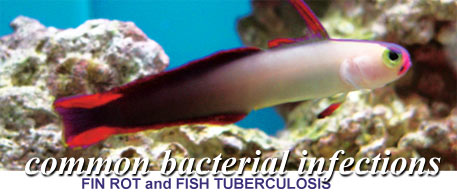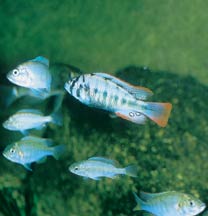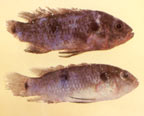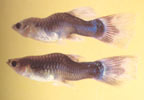
 Bacteria are present everywhere on both land and in the water and are normally classified as either 'good' bacteria or 'bad' bacteria.
Bacteria are present everywhere on both land and in the water and are normally classified as either 'good' bacteria or 'bad' bacteria.
The good bacteria in the aquarium consist of the ones that make up the biological filter. These bacteria break down ammonia and nitrate so that it can be removed from the water. Without good bacteria most life would not be able to exist.
The bad bacteria are often bacteria that are normally present but don't cause problems until the fish is injured, stressed or suffering from another disease. These bad bacteria take advantage of the compromised animal's weakened immune system and reproduce extremely quickly, creating the resultant sicknesses and problems.
The key to dealing with any bacterial infection is early recognition and
treatment. Of course, prevention through
careful introduction of new fish, plants and water, as well as maintaining a healthy, stress-free environment for your fish, is still the best course of action.
This two-part article will assist you in the identification and treatment of some of the more common bacterial infections in fish.
Fin Rot
Signs: Fin rot often begins with red streaks in the fins that are soon followed by abnormal lightening of the edge of the fin and then a fraying or rotting of the fin membrane and edges. This infection can lead to a complete rotting of the fin and can spread to the body and lead to death.
 Cause: Aeromonas, Pseudomonas and Flexibacter
Cause: Aeromonas, Pseudomonas and Flexibacter
Transmission: Infection occurs from bacteria that are already in the water but do not cause problems in healthy fish. Injury to the fins, stress, or poor water quality can all lead to an increase in these infections.
Treatment: Infected fish can be bathed in a salt solution (make sure your species of fish can tolerate this) or given topical treatment of the affected area with Gentian Violet. Treatment tanks with appropriate antibiotics are sometimes also used. Correcting water problems and removing fighting fish are also necessary to prevent reoccurrence.
Fish Tuberculosis
Signs: Fish with tuberculosis usually show a loss of appetite, pale skin color, emaciation, lethargy, skin ulcers, and general poor health. The disease may progress slowly leading to skeletal deformities and eventually death. Post mortem exam will reveal small white nodules in the internal organs.
Cause: Mycobacterium
 Transmission: The bacteria can be transmitted through the water from open ulcers, feces of infected fish, or through the consumption of infected, dead or dying fish in the tank.
Transmission: The bacteria can be transmitted through the water from open ulcers, feces of infected fish, or through the consumption of infected, dead or dying fish in the tank.
Predisposing factors: This disease is not highly contagious, however it is often associated with poorly kept or dirty tanks with poor water quality. Any dead fish should quickly be removed and disposed of. Diseased live fish should be removed to a treatment tank.
Treatment: The antibiotics kanamycin or erythromycin are sometimes successful. All infected fish should be handled with care to prevent transmission to humans through open wounds or cuts.
Part 2 of this article discusses skin ulcers and Vibriosis, two additional common bacterial infections in fish.
|